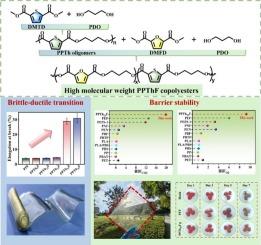Modification of poly(propylene 2,5-furandicarboxylate) with 2,5-thiophenedicarboxylic acid with enhanced mechanical and barrier performance
IF 6.3
2区 化学
Q1 POLYMER SCIENCE
引用次数: 0
Abstract
Bio-based materials provide solutions with both ecological benefits and technical feasibility for replacing traditional petroleum-based materials. This study focused on poly(propylene 2,5-furandicarboxylate) (PPF), a fully bio-based polyester with promising gas barrier properties. However, the lack of mechanical properties has become a key bottleneck in its packaging applications. Aiming at the problems of low molecular weight of PPF, Poly (propylene 2,5-thiophenedicarboxylate) (PPTh) oligomer prepared from 2,5-thiophenedicarboxylic acid and 1,3-propanediol was used to modify PPF, and high molecular weight poly(propylene 2,5-thiophenedicarboxylate-co-2,5-furandicarboxylate) (PPThF) copolyesters were prepared by melt polycondensation. The experimental results exhibited excellent CO2 and O2 barrier properties of up to 29.0 and 9.3 times compared with those of PET, respectively. Crucially, a brittle-ductile transition occurs without sacrificing barrier properties (elongation at break increases from 4.6% to 29%). These findings indicate that the material has the potential for packaging materials.

2,5-噻吩二羧酸改性聚(2,5-呋喃二羧酸丙烯)增强机械性能和阻隔性能
生物基材料为替代传统的石油基材料提供了既具有生态效益又具有技术可行性的解决方案。本研究的重点是聚(2,5-呋喃二羧酸丙烯)(PPF),一种具有良好气体阻隔性能的全生物基聚酯。然而,缺乏机械性能已成为其包装应用的关键瓶颈。针对PPF分子量低的问题,以2,5-噻吩二羧酸和1,3-丙二醇为原料制备聚(2,5-噻吩二羧酸酯-2,5-呋喃二羧酸酯)(PPTh)低聚物对PPF进行改性,采用熔融缩聚法制备了高分子量聚(2,5-噻吩二羧酸酯-2,5-呋喃二羧酸酯)(PPThF)共聚酯。实验结果表明,该材料的CO2和O2阻隔性能分别是PET的29.0倍和9.3倍。最关键的是,在不牺牲屏障性能的情况下实现脆性-韧性转变(断裂伸长率从4.6%增加到29%)。这些发现表明该材料具有作为包装材料的潜力。
本文章由计算机程序翻译,如有差异,请以英文原文为准。
求助全文
约1分钟内获得全文
求助全文
来源期刊

European Polymer Journal
化学-高分子科学
CiteScore
9.90
自引率
10.00%
发文量
691
审稿时长
23 days
期刊介绍:
European Polymer Journal is dedicated to publishing work on fundamental and applied polymer chemistry and macromolecular materials. The journal covers all aspects of polymer synthesis, including polymerization mechanisms and chemical functional transformations, with a focus on novel polymers and the relationships between molecular structure and polymer properties. In addition, we welcome submissions on bio-based or renewable polymers, stimuli-responsive systems and polymer bio-hybrids. European Polymer Journal also publishes research on the biomedical application of polymers, including drug delivery and regenerative medicine. The main scope is covered but not limited to the following core research areas:
Polymer synthesis and functionalization
• Novel synthetic routes for polymerization, functional modification, controlled/living polymerization and precision polymers.
Stimuli-responsive polymers
• Including shape memory and self-healing polymers.
Supramolecular polymers and self-assembly
• Molecular recognition and higher order polymer structures.
Renewable and sustainable polymers
• Bio-based, biodegradable and anti-microbial polymers and polymeric bio-nanocomposites.
Polymers at interfaces and surfaces
• Chemistry and engineering of surfaces with biological relevance, including patterning, antifouling polymers and polymers for membrane applications.
Biomedical applications and nanomedicine
• Polymers for regenerative medicine, drug delivery molecular release and gene therapy
The scope of European Polymer Journal no longer includes Polymer Physics.
 求助内容:
求助内容: 应助结果提醒方式:
应助结果提醒方式:


